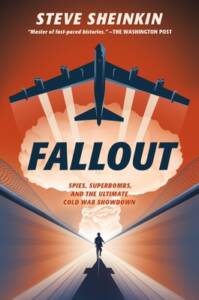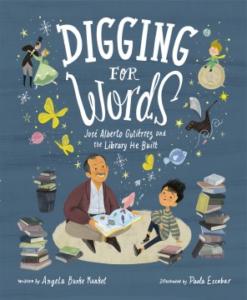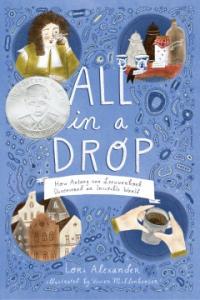Fallout: Spies, Superbombs, and the Ultimate Cold War ShowdownDecember 2022

Sheinkin, Steve. Fallout: Spies, Superbombs, and the Ultimate Cold War Showdown. Roaring Brook Press: New York, 2021.
This history of the Cold War reads like a novel (but you can’t make this stuff up) and focuses on the main players at various crisis points in the era. From post-WWII spy trade to prisoner swaps to the Cuban Missile Crisis and the Berlin Wall, it’s all thrilling. Includes photographs, source notes, bibliography, and index.
It’s a must-have for any school serving students Grade 7 and up. Would also recommend to adults who will appreciate the overlap with other books and movies.
Dewey: 972.9106 Interest Level: Grades 6 – 12
Awards and Reviews: ALA Notable Children’s Books; Booklist starred, Bulletin of the Center for Children’s Books starred; Horn Books starred; Kirkus Reviews; New York Times; Publishers Weekly starred; Sibert Award, 2022; School Library Journal starred.
Younger readers might like: Cold War Correspondent (Nathan Hale’s Hazardous Tales, Book 11) by Nathan Hale
Fiction pairing: A Night Divided by Jennifer Nielsen
On the web: Find details on virtual tours of the Spy Museum!
Watch: Bridge of Spies (2015) from Stephen Spielberg. Rated PG-13.
Nonfiction Book Archives

Kunkel, Anglea Burke. Digging for Words: José Alberto Gutiérrez and the Library He Built. New York: Schwartz & Wade, 2020.
Two Josés live in the La Nueva Gloria neighborhood of Bogotá, Columbia. They both love books and they both look forward to Saturdays. Why? It’s the day Grown-up José opens the library he created to all the people who live in his neighborhood. Young José waits all week to visit the library to pick out a book to take home and read. José’s library holds all types of books for readers young and old, all delighting in selecting just the right story. Grown-up José is a garbage collector by night and keeps a keen eye out for discarded books on his route and then brings them back to his library.
This is a charming story that highlights the adventure and fun that can happen through a great book, as well as the efforts of one man to bring literacy to his neighborhood. The digitally rendered illustrations bring to life the daily routines of both Josés, and the places their imaginations go when the read. The text is mostly English, but there are Spanish words worked into the text, too.
According to the Author’s note, there are only nineteen libraries in all of Bogotá, a city of more than 10 million people. Until José the garbage collector took matters into his own hands, there wasn’t any library service at all in the Josés’ neighborhood. Several books are described when characters read them, and those books are listed at the back of the book, just in case anyone is curious to read them, too.
Digging for Words should be a purchase for any picture book collection!
Dewey: E Interest Level: PreK-Gr 2
Awards and Reviews: Booklist; Horn Book Magazine; Kirkus Reviews starred; SLJ Xpress starred.
Another great story about a librarian: Planting Stories: The Life of Librarian and Storyteller Pura Belpre by Anika Denise.
And another story about making something great out of something discarded: Ada’s Violin: the Story of the Recycled Orchestra of Paraguay by Susan Hood.
On the web: an article from the BBC about the real José: https://www.bbc.com/news/education-40173423

Gates, Melinda. The Moment of Lift: How Empowering Women Changes the World. New York: Flatiron Books, 2019.
Got some high school students who are interested in taking on the world and making it a better place? Melinda Gates isn’t a bad source for advice. In The Moment of Lift, she describes her journey through philanthropy, lessons learned about how to approach problems, and how to determine the best places to invest resources. She’s discovered that listening to the people you’d like to help is at the foundation of it all. It is evident in the title that Gates’ work focuses on empowering women around the world, but even if the reader isn’t interested in those causes, the lessons for working in philanthropy can be applied to projects large and small. Some shocking topics are discussed here including forced marriage, child brides, female mutilation, and abuse, but there are no graphic descriptions.
Young adults will be encouraged by the stories of how Gates, one of the world’s most wealthy and powerful women, had to start at the start when it came to learning about new issues. No one begins a new endeavor with perfect knowledge, or sometimes any real knowledge about the solutions that will work best. But what makes this more engaging than a how-to manual are the personal stories that brought about learning and epiphanies for Gates, herself, told in a matter of fact, humble style.
The Moment of Lift is an important addition to high school collections, especially for those schools who have a service-learning program. It’s clearly written in language accessible to high school students, and it is informative, heartbreaking, personal, and very inspiring.
Dewey: 305.42 Interest Level: Adult
Awards and Reviews: Booklist starred; Kirkus Reviews; Library Journal; Publishers Weekly Annex.
Younger Readers might like: 111 Trees: How One Village Celebrates the Birth of Every Girl by Rina Singh
Middle School Readers might like: Because I Am a Girl: I Can Change the World by Rosemary A. McCarney
Fiction Pairing: Among the Fallen by Virginal Frances Schwartz

Tekiela, Stan. Whose House Is That? Cambridge, MN: Adventure Publications, 2021.
Younger students that are interested in spotting wildlife might use Whose House is That? as a guide to outdoor adventure this summer, since nearly all the animals mentioned live in Idaho. Some can even be spotted in the back yard or the neighborhood park!
Whose House Is That? employs a question-and-answer format with a few clues and a photograph of an animal’s home on a pleasing double page spread. After pondering the clues, the reader turns the page to find the answer and a photo of the animal in question with facts and pronunciation guides for unfamiliar words. To continue the fun, readers can try the animal house scavenger hunt suggested on the last page, complete with a safety note and a reminder to keep your distance from wildlife and their homes. The beautifully clear photographs are the stars of this title and students may want to linger on them.
Whose House Is That? would make a worthwhile addition to any elementary library’s wildlife collection. When read aloud, time outside afterward to look for animals’ homes is a must!
Dewey: 590 Interest Level: Grades 1-4
Awards and Reviews: Kirkus Reviews
Older students might like: Adventure Is Out There: Over 50 Creative Activities for Outdoor Explorers by Jenni Lazell
Young Adult Readers might like: Scats and Tracks of North America: A Field Guide to the Signs of Nearly 150 Wildlife Species by James C. Halfpenny.
Fiction Pairing: Fishbone’s Song by Gary Paulsen
On the Web: Students can find more of Tekiela’s wildlife photos on his website, Nature Smart. It's an information-packed reource and well worth a visit.

Jamieson, Victoria and Omar Mahamed. When Stars are Scattered. New York: Dial Books for Young Readers, 2020.
Memoir might not technically be nonfiction, but this memoir is so good that we are extending the reach of the Nonfiction Book of the Month to “nearly” nonfiction this month.
When Stars are Scattered is the true story of Omar, the older brother who cares for Hassan, the younger brother, who is developmentally disabled and mostly nonverbal. The brothers flee Somalia as small children and grew up in a refugee camp in Kenya, without either parent. Their father was killed in Somalia, and they lost their mother in the chaos of running from the war. Along with their loving foster mother assigned to them when they arrive at the camp, Omar does his best to care for and protect Hassan as they search for their mother, and avoid the hazards of camp life. Omar is very smart and is accepted into the high school at the camp and, consequently better their chances for relocation. While this is a wonderful development, Omar and Hassan must then also navigate the years-long refugee relocation process. All while hungry all the time.
Day-to-day life is sometimes like life in other places: walking to school with friends, dealing with rivals and bullies, and doing chores and homework. But some events reveal some real differences in customs like when a school friend’s family forces her to quit school and get married.
Jamieson’s artful storytelling and Mohamed's compelling life make this book an accessible look into refugee life for students from 4th grade and up. The afterward tells us where Omar and Hassan are now, which elements of the story are fiction, and more about the refugee experience. While the circumstances of the story are bleak, Jamieson and Omar include moments of levity and humor to balance the heartbreak and hopelessness. Put this title on the top of your shopping list!
Dewey: 305.9 Interest Level: Grades 4 and up
Awards and Reviews: Booklist starred; Horn Book Magazine starred; Kirkus Reviews starred; Publishers Weekly starred; Schneider Family Book Honor; School Library Connection starred; School Library Journal starred.
Older students might like: The Unwanted: Stories of the Syrian Refugees by Don Brown.
Younger students might like: Adrift at Sea: A Vietnamese Boy’s Story of Survival by Marsha Forchuk Skrypuch.
Fiction pairing: Other Words for Home by Jasmine Warga
Learn about the refugee community in Idaho at the Idaho Office for Refugees, including the Refugees Speakers Bureau.

Seiple, Samantha. Nazi Saboteurs: Hitler’s Secret Attack on America. New York: Scholastic Focus, an imprint of Scholastic, Inc., 2019.
Are there any elements of World War II that haven’t been thoroughly covered by fiction and non-fiction alike? While it surely depends on the expertise of the reader, there are a few details in Nazi Saboteurs that seem like home front knowledge bombs: the Japanese invaded Alaska (what ?!?) and German saboteurs came ashore in New York and Florida.
Even if the history book version has been covered, this is the story told from the point of view of the Saboteurs, only a few of them Nazi true believers. They found themselves in the United States with explosives, cash, and a mission to destroy infrastructure and industrial targets to disrupt the Allied war effort. They were trained with the usual Nazi efficient fervor, but they didn’t trust one another, and, according to many of them, their hearts weren’t in the mission. Rather, they would rather reunite with family in the U.S., help trip up the German war effort, and/or get to South America.
Nazi Saboteurs follows these eight figures as their lives lead up to the well-funded but doomed plot, as some of them work to expose the mission, and the consequences of their actions along the way. Seiple uses photographs to great benefit but following eight characters with their own agendas sometimes gets a little muddled. Still, this is a solid take on WWII on the home front and a page-turner, too.
The last chapter compares the German sabotage effort and the events that followed with 9/11 and its aftermath. Back matter includes a description of source documents (some of which are declassified court transcripts and FBI records), and an index. Features primary sources. A valuable addition to an upper elementary or middle school collection.
Dewey: 940.54 Interest Level: Grades 4-8
Awards and Reviews: Booklist, Kirkus, School Library Connection, School Library Journal
Older students might like: The Boys Who Challenged Hitler, by Phillip Hoose
Fiction pairing: The Good War, by Todd Strasser
On the Web: The FBI’s Famous Cases and Criminals: Nazi Saboteurs and George Dasch. FBI’s official take on the case.
Smithsonian Magazine: G-Men and Nazi Spies video from 1941 describing the plot featuring J. Edgar Hoover.

Charleyboy, Lisa and Mary Beth Leatherdale (editors). #NotYourPrincess: Voices of Native American Women. Toronto, Ontario, Canada: Annick Press, 2017.
#NotYourPrincess is an award winning title with rave reviews but, when I opened this title, I was not expecting to be so moved by the poetry, essays, art and all the other works collected here. This anthology of unflinching, personal, and sophisticated contributions from North American Indigenous women and teenage girls, when taken together, provide a glimpse of the world as experienced by Indigenous women. Weeks after my first reading, I find myself thinking about the collection and the women who contributed. If ever I meet Charleyboy or Leatherdale, I will thank them, for if there is an exemplar of a windows-and-mirrors sort of book, this is it.
#NotYourPrincess deals with some heavy topics and is most appropriate for a high school library, but possibly a junior high library. It isn’t that there is anything overly graphic, but it would be most appreciated and understood by an older set. If #NotYourPrincess is not in your high school collection yet, consider purchasing it.
For an in-depth review of #NotYourPrincess: Voices of Native American Women, and recommendations on many other titles featuring American Indians, visit American Indians in Children’s Literature (AICL) from Dr. Debbie Reese and Dr. Jean Mendoza at https://americanindiansinchildrensliterature.blogspot.com/. Along with critical analysis on books, the AICL website provides a wealth of information for those of us who could use a little guidance in this area.
Dewey: 971.004 Interest Level: YA
Awards and Reviews: American Indian Youth Literature Award, 2018; Booklist, Kirkus Reviews starred; Publishers Weekly; Resource Links; School Library Journal starred; Voices of Youth Advocates (YOYA) starred; YALSA Award for Excellence in Nonfiction for Young Adults – Nominees, 2018.
Younger students might like: Ancestor Approved Intertribal Stories for Kids by Cynthia Leitich Smith
Middle school students might like: I Will See You Again by Lisa Boivin
Fiction pairing: Firekeeper’s Daughter by Angeline Boulley

Hale, Nathan. Big Bad Ironclad, Nathan Hale’s Hazardous Tales, Book 2. New York: Amulet Books, 2012.
Big Bad Ironclad is not a new title, and it probably is in many collections already, so why add it to this list now? Book 10 in the Hazardous Tales Series was just released in November 2020 (Blades of Freedom), and the series shows that good things can happen for students when history gets the graphic novel treatment.
Big Bad Ironclad tells the story of the Merrimack (renamed the Virginia) and the Monitor, the two first ironclad ships in the American and Confederate navies, and the plan called Anaconda to blockade Confederate ports.
Throughout the Hazardous Tales series, Nathan Hale, (the not-so-good spy from the American Revolution, not the author) delays his hanging by telling stories about history. Luckily, he knows future history as well as past history, and has similar sense of humor as Nathan Hale, the author. Literally gallows humor. As funny and engaging as they are, these books are well-researched, characters are developed and have personalities, and stories are accessible and accurate. A must have for any elementary library, and perhaps middle school libraries, too.
Dewey: 973.7 Interest Level: Grades 3-7
Awards and Reviews: Horn Book Guide starred, Kirkus Reviews, School Library Journal, Voice of Youth Advocates (VOYA).
Younger readers might like: The Mad Scientist Academy series by Matthew McElligott
Older readers might like: Max Axiom, Super Scientist Series by various authors.
Fiction pairing: A Light in the Storm: The Civil War Diary of Amelia Martin by Karen Hesse (A Dear America book).
On the web: The Nathan Hale YouTube Channel – Learn more about comics, inking, drawing, and history at https://www.youtube.com/channel/UC3DbpqPsF1nzFiBoJqFeKpw.
The Monitor and Merrimack on YouTube at https://www.youtube.com/watch?v=uQpdUOwFIac.
Find photographs and portraits of Lt. William B. Cushing at https://www.history.navy.mil/our-collections/photography/us-people/c/cushing-william-barker.html
Alexander, Lori. (illus. Vivien Mildenberger). All in a Drop: How Antony van Leewenhoek Discovered an Invisible World. Boston, MA: Houghton Mifflin Harcourt, 2019.
Antony van Leewenhoek didn’t invent the microscope. However, by developing his own techniques, he improved the microscope so much that he could see things through the lenses that others could not see through lesser microscopes. This charmingly illustrated scientific biography shows how one curious man discovered microscopic creatures. Although he was educated in a scientific field, he was fascinated with microscopes and the microscopic world. In a way, his lack of formal training freed Antony from the confines of what was already presumed to be “known,” making him open to new discoveries in ways more experienced scientists might dismiss.
Beyond reporting on Antony’s life and work, Alexander reflects upon the idea that since Antony was so secretive about his microscopes and how they were built, he may have inhibited further discovery. Would we know more now if Antony had been more forthcoming, or would someone have stolen his methods and assigned him to obscurity? Of course, we’ll never know.
All in a Drop is a necessary addition to any elementary school collection, and possibly middle school, too. The timeline in the back is helpful in putting Antony’s work in the context of other scientific advancements. There is also a glossary, source notes, additional reading, and other helpful reference materials that are present in non-fiction of this quality.
Dewey: 579.092 Interest Level: Grades 2-6
Awards and Reviews: Booklist starred, Bulletin of the Center for Children’s Books, Horn Book, Kirkus Reviews, Publishers Weekly, Robert F. Sibert Informational Book Honor 2020, School Library Journal
Younger readers might like: Tiny Monsters: The Strange Creatures that Live On Us, in Us, and Around Us by Steve Jenkins
Older readers might like: Invisible Allies –Microbes that Shape Our Lives (2nd Edition) by Jeanette Farrell
Fiction pairing: The Evolution of Calpurnia Tate by Jacqueline Kelly
On the Web: Find open access information on the papers of van Leeuwenhoek from The Royal Society (The very same one to which Antony corresponded) at https://royalsocietypublishing.org/doi/10.1098/rstb.2014.0344
Yang, Kao Kalia. (Illus. Khoa Le). The Most Beautiful Thing. Minneapolis, MN: Carolrhoda Books, an imprint of Lerner Publishing Group, Inc., 2020.
If The Most Beautiful Thing ends up in a school’s collection just for the illustrations, it would be a good thing. When the story is shared, it will be even better. This gorgeous book is the story of the author’s family’s immigration to the United States as Hmong refugees. It is not the story of the journey, but the story of learning how to live with very little. It is told in simple, almost poetic language from the author’s point of view as she grows from a small child to a teen. Themes of familial love, enduring hardship and poverty, and tradition make the text and the illustrations that much richer. Students that are living with hardship brought on by COVID may relate to descriptions of doing without.
The Most Beautiful Thing is a must-buy for elementary libraries’ picture book collection, and although the interest level is K-3, it leans more toward the older end of that range. It includes a short pronunciation guide and glossary.
Dewey: 305 Interest Level: Grades 1-4.
Awards and Reviews (as of October 7): Kirkus Reviews starred.
Older Readers Might Like: Kids Like Me: Voices of the Immigrant Experience by Judith M. Blohm (Gr. 5-8)
Young Adult Readers Might Like: Immigration Nation: The American Identity in the Twenty-First Century by Judy Dodge Cummings.
Fiction Paring: Danbi Leads the School Parade by Anna Kim

Rajcak, Hélène. (Illus. Damien Laverdunt). Unseen Worlds: Real-Life Microscopic Creatures Hiding All Around Us. Tonbridge, Kent, UK: What On Earth Books, 2019.
Unseen World might not be the right book for those every-ready for a case of the heebie-jeebies. However, for those that are interested in the microscopic world, it fits the bill! With the richly detailed, scaled to much larger than life illustrations, fans of all things science and fans of all things gross will love getting their hands on this book.
Rajcak has organized the book’s content around where to find groups of microscopic creatures: underwater, at the beach, in your bed (yikes!), on your skin (double yikes!), in the forest, in your kitchen (ew!), and more. The text describes each ecosystem in just the right amount of detail, with the unusual feature of an icon that shows how much magnification is required to see the image shown. The fold out flap on every page provides details on each creature that is shown on the accompanying double page spread.
Rajcak gives us end matter worth reading to the last page: one page on microscopes including an easy-to-follow diagram; a short lesson on scale and magnification, and more. We also get a short history of the microscope, a lesson on classifying Microorganisms, a glossary, and an index.
Unseen Worlds: Real-Life Microscopic Creatures Hiding All Around Us is a first-tier priority for any elementary school and middle school/junior high 500 section.
Dewey: 590 Interest Level: Grades 3-7
Awards and Reviews: Kirkus Reviews, School Library Journal starred, Booklist, Publishers Weekly.
Younger Readers might like: The Book of Brilliant Bugs by Jess French (Illus. Claire McElfatrick)
Young Adult readers might like: World of Microbes: Bacteria, Viruses, and Other Microorganisms by Janie Levy.
Fiction pairing: Bugs in My Hair! by David Shannon
On the Web: Nikon’s Museum of Microscopy at https://www.microscopyu.com/museum
